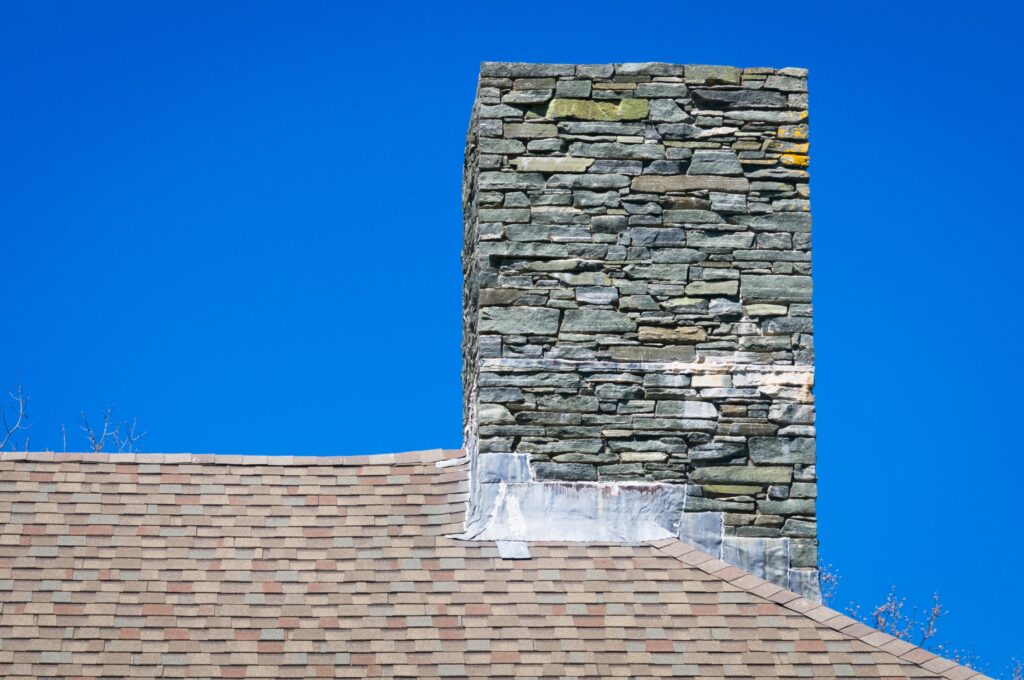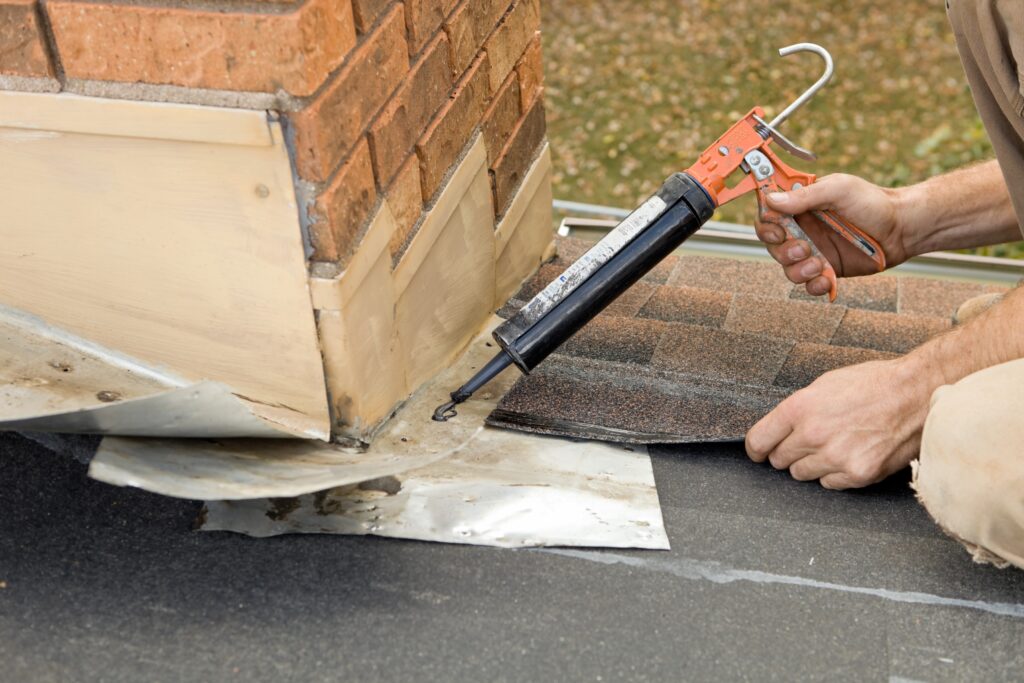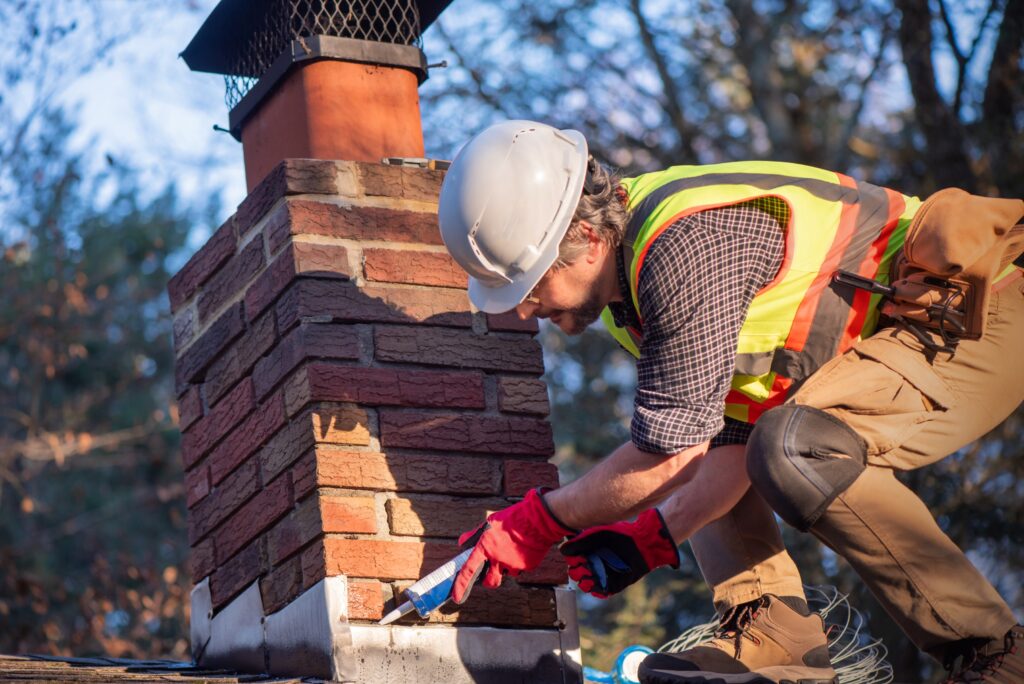Your chimney’s flashing system quietly protects your home 24/7, yet most homeowners never think about it until disaster strikes. When this critical barrier fails, the resulting water damage can cost tens of thousands of dollars in roof repairs. The good news? Most chimney flashing repair emergencies are completely preventable with the right knowledge and proactive approach.
Why Your Chimney Flashing Deserves Your Attention Right Now
Think of chimney flashing as your home’s raincoat at its most vulnerable point. Where your chimney meets your roof creates a natural weak spot that water constantly tries to exploit through roof leaks. Without proper protection, this junction becomes a gateway for moisture that can silently destroy your walls, ceiling, and even your home’s structural foundation through water infiltration.
The flashing system around your chimney works like a sophisticated drainage network designed to direct water away from vulnerable areas.
Base Flashing
Base flashing channels water away from the chimney’s vertical surface, while step flashing guides moisture down the roof’s slope.
Counter Flashing
Counter flashing, embedded deep into the mortar joints, creates the final barrier against water damage.
When these components work together harmoniously, they divert water so effectively that you’ll never know they’re there.

However, when existing chimney flashing begins to fail, the consequences escalate quickly. What starts as small cracks in the flashing material can become a major water highway, allowing hundreds of gallons to penetrate your home during heavy rain or snow accumulation. This water infiltration often remains hidden for months, silently rotting structural components and creating perfect conditions for dangerous mold growth around the chimney area.
Professional chimney flashing repair becomes inevitable when homeowners ignore early warning signs. The existing flashing that once protected your home transforms into a liability, requiring immediate attention from contractors with all the necessary tools and safety gear to address the problem properly.
Decoding Flashing Materials: Your Options Explained
Selecting the right flashing material dramatically impacts your system’s longevity and performance against extreme weather conditions.
Copper Flashing
Copper flashing stands as the premium choice, offering exceptional durability that can protect your home for decades when properly installed. Its natural resistance to hot weather and freeze-thaw cycles, combined with its ability to develop a protective patina over time, makes it ideal for homeowners seeking long-term protection for their new chimney or existing chimney.
Aluminum Flashing
For budget-conscious homeowners looking to replace flashing without breaking the bank, aluminum alternatives provide excellent value. Modern aluminum flashing resists corrosion effectively while maintaining flexibility during temperature fluctuations that could compromise other materials. The flashing material maintains its watertight seal even when exposed to extreme weather, making it a popular choice for roof repairs.
Steel Flashing
Steel options offer superior strength for challenging installations but require careful consideration of coating quality to prevent premature rust formation around your chimney. Contemporary sheet metal solutions have revolutionized flashing installation, providing contractors with materials that conform perfectly to complex chimney configurations while ensuring a waterproof seal that lasts.
When contractors replace chimney flashing with modern materials, they can achieve better performance than old flashing ever provided. These advanced materials expand and contract smoothly with temperature changes, maintaining their protective properties year after year. The key lies in matching material selection to your climate challenges and ensuring the new flashing integrates seamlessly with shingles surrounding the installation area.
Red Flag Warning Signs That Demand Immediate Action
Smart homeowners learn to recognize the subtle signs that existing flashing is beginning to fail before expensive roof repairs become necessary.
Water Damage
Water damage appearing near your fireplace or on nearby walls often provides the first clue that your waterproof seal has been compromised. These signs may start as barely noticeable discoloration but can rapidly expand into obvious damage requiring extensive maintenance work.
Visible Physical Damage
External inspection reveals additional critical warning signals that shouldn’t be ignored during your annual inspections. Loose sections of roof flashing, visible cracks in sealing compounds, or gaps between flashing and your chimney’s vertical surface all indicate immediate flashing repair is needed. Pay special attention to areas where old flashing meets the shingles surrounding your chimney, as these transition zones experience the greatest stress during heavy rain and snow.
Mortar Damage
During late summer maintenance checks, examine the mortar joints where counter flashing should be properly installed. Deteriorating mortar allows water infiltration behind the flashing system, potentially causing significant structural damage long before problems become visible inside your home. Any movement or separation of existing chimney flashing from the chimney’s surface requires professional evaluation to prevent further damage.

Look for rust spots on sheet metal flashing or green oxidation on copper flashing that indicates the material is nearing replacement time. When flashing material shows these signs of wear, it’s time to consider having professionals replace flashing before the next storm season. Damaged chimney flashing that’s ignored will inevitably lead to more expensive roof leaks and interior water damage.
The bricks around your chimney may show white staining when water penetration occurs, signaling that your existing flashing isn’t providing adequate protection. These signs become more pronounced after periods of heavy rain or when snow melts rapidly around the chimney area.
The Game-Changing Impact of Professional Installation
Installing flashing correctly requires specialized knowledge, precision techniques, and all the necessary tools to ensure decades of reliable performance. Professional contractors understand that accurate measurements and proper installation sequencing are non-negotiable elements of successful chimney repair projects. They recognize that even minor installation shortcuts can compromise the entire system, leading to expensive remediation projects that could have been avoided.
Quality installation begins with thorough preparation of the work area around your chimney. This includes completely removing existing chimney flashing, inspecting underlying structures for damage, and ensuring the roof deck provides a solid foundation. Professional teams use appropriate safety gear while following established protocols that protect both workers and your property throughout the flashing repair process.
The right tools make all the difference when contractors replace chimney flashing or perform maintenance work. Professional installation also involves careful integration with the chimney cap and other protective elements that work together to prevent water infiltration. When installed correctly, the new flashing system will protect your home through countless cycles of hot weather, heavy rain, snow, and extreme weather events.
Seasonal Maintenance Secrets That Extend Flashing Life
Implementing strategic seasonal maintenance routines dramatically extends your flashing system’s service life while preventing costly flashing repair emergencies. Spring maintenance focuses on assessing winter damage, particularly the effects of ice dams and freeze-thaw cycles that can compromise even properly installed systems. This season provides optimal conditions for annual inspections to identify areas where extreme weather may have created new vulnerabilities around the chimney.
Spring is also the ideal time to inspect how your chimney serves during the heating season and check for any signs of water damage that may have occurred during snow melt. Look for loose or damaged sections of existing flashing that may need attention before the next winter season arrives.
Summer represents the perfect time for cleaning and minor repair work before autumn weather arrives. Remove accumulated debris from around your chimney area, inspect caulk integrity throughout the system, and verify that all sealing compounds remain flexible despite hot weather exposure. The warm conditions make flashing materials more workable, creating perfect conditions for minor adjustments or preventive resealing projects.
Fall preparation activities focus on comprehensive system evaluation and winterization procedures before extreme weather arrives. Ensure your chimney cap functions properly, as this component works collectively with your flashing system to prevent water infiltration during challenging winter months. Verify that gutters and downspouts effectively direct water away from the chimney area, preventing pooling that could overwhelm even the best-maintained flashing system.
Late summer and early fall provide the last opportunity for major maintenance before winter weather makes outdoor work dangerous. This is the time to replace flashing if inspection reveals significant wear or damage that could lead to problems during heavy rain or snow accumulation.

Annual Inspections: Your Best Defense Against Expensive Surprises
Professional annual inspections represent the single most cost-effective strategy for avoiding expensive chimney flashing repair emergencies. Certified inspectors possess the training and experience necessary to identify subtle problems in existing chimney flashing that untrained individuals typically miss. They understand how system components interact and can predict when you’ll need to replace chimney flashing before emergency situations develop.
Comprehensive inspections evaluate your entire chimney system, not just the visible flashing components around your chimney. This holistic approach ensures your chimney meets current safety standards while operating at peak energy efficiency levels. Inspectors check ventilation adequacy, structural integrity of bricks and mortar joints, and compliance with evolving building codes that affect system performance.
During annual inspections, professionals examine the condition of existing flashing materials, checking for signs of wear that might require flashing repair or complete replacement. They assess how well the watertight seal is holding up and whether any sections of step flashing or base flashing show signs of failure.
Professional inspection documentation provides invaluable historical data about your system’s condition trends over time. This information helps identify recurring issues or patterns that might indicate underlying problems requiring maintenance attention. Detailed inspection reports also provide essential documentation for insurance claims should weather damage occur despite your preventive efforts.
The final inspection after any repair work ensures that new flashing has been properly installed and that your chimney meets all safety and performance standards. This thorough evaluation process helps prevent future problems and extends the life of your investment.
The Financial Wisdom of Preventive Maintenance
Investing in preventive maintenance delivers remarkable long-term savings compared to emergency repair costs that catch homeowners unprepared. Minor flashing repair work typically requires hundreds of dollars, while projects to replace chimney flashing can exceed several thousand dollars depending on the complexity of your roof design. More significantly, water damage resulting from failed flashing systems can require extensive interior reconstruction affecting multiple rooms and building systems throughout your home.
The cost difference between preventive maintenance and emergency roof repairs highlights the importance of regular attention to your flashing system. When you ignore early warning signs, a simple flashing repair job can escalate into a complete roof replacement project that costs tens of thousands of dollars.
Improving energy efficiency lowers heating and cooling costs year after year. A well-sealed building prevents air leaks and moisture from weakening the insulation around your chimney. These upgrades make preventive maintenance more worthwhile as energy prices keep rising.
Your Next Steps Toward Lasting Protection
TOR Chimney understands that every chimney serves unique challenges based on roof design, flashing material selection, and local climate conditions. We use only the highest-quality materials and proven installation techniques that ensure your new flashing provides reliable protection for decades.
Contact us today to schedule your consultation and discover how our proven expertise can save you thousands in potential repair costs while ensuring your existing chimney flashing performs optimally. After conducting a thorough final inspection of your entire system, our professionals will provide detailed recommendations and maintenance schedules specifically tailored to your property’s unique requirements.
Trust the experts who understand that your chimney serves as far more than a functional component – it’s a critical element of your home’s protection system that deserves specialized professional care and attention. Let us help you maintain the watertight seal that keeps your family safe and your home protected from water infiltration and costly damage.














